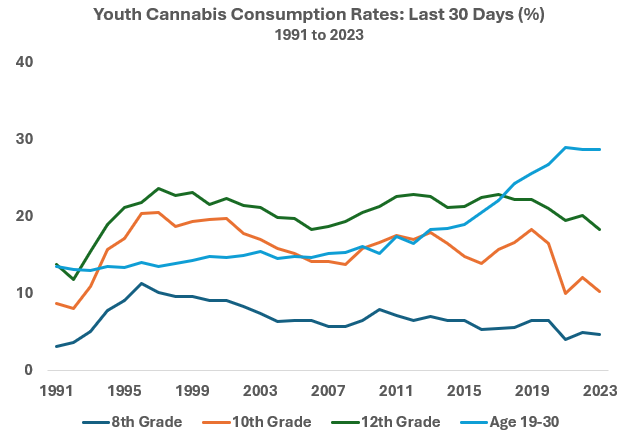By the Numbers: Surprising Shifts in Youth Substance Use (Part I)
The landscape of youth substance use is transforming in unexpected ways.
Traditional concerns show encouraging declines among teens, yet new challenges emerge—particularly among young adults—as substances become more potent and their intersection with mental health grows more complex.
In this first installment of our four-part series, we'll examine the surprising national data reshaping our understanding of youth substance use, setting the stage for deeper dives into Bay Area trends (Part 2), marijuana use (Part 3), and the opioid crisis (Part 4).
_______________
Understanding the Big Picture: National Trends
The national context provides essential background for our local Bay Area analysis. Drawing from the Monitoring the Future survey, funded by the National Institutes of Health, we can track how substance use patterns have evolved across the country.
While survey data typically understates actual usage rates, these long-term trends provide crucial context for understanding both our local challenges and assessing where we stand today.
The data reveals distinct patterns for the three most commonly used substances among youth: alcohol, cannabis, and nicotine vaping, with trends varying significantly between teens and young adults (ages 19-30). Each tells a different story about changing youth behaviors and preferences.
_______________
Alcohol: A Promising Decline
The most striking trend in recent decades has been the dramatic decrease in alcohol consumption among teenagers. Since 1991, we've seen remarkable reductions across all age groups:
8th graders: 76% decrease
10th graders: 68% decrease
12th graders: 55% decrease
Current data shows that regular teen drinkers are now in the minority, with only 6% of 8th graders, 14% of 10th graders, and 24% of 12th graders reporting recent alcohol consumption.
Young adults show a more modest decline, with usage rates dropping from 71% in 1991 to 65% in 2023.
_______________
Cannabis: A Mixed Picture
The cannabis landscape presents a more complex picture than alcohol. Teen usage has decreased from peak levels, and research suggests that to date, marijuana legalization efforts haven't significantly increased teen usage.
The most dramatic change appears among young adults, where usage rates have more than doubled—rising from 14% to 29%, representing an over 100% increase since 1991. This stark contrast between teen and young adult consumption patterns merits careful consideration as we develop prevention and intervention strategies.
_______________
Vaping Nicotine: An Ongoing Threat
While traditional cigarette usage has fallen to just 1-3% over three decades, e-cigarettes have emerged as a significant concern, with growing evidence of serious health risks including lung damage and heightened addiction potential among youth.
Key trends since tracking began in 2017:
Teen usage surged 150% from 2017 to 2019-2020, but has since declined. Current rates: 7% of 8th graders, 12% of 10th graders, and 17% of 12th graders
Young adult usage has more than tripled from 6% to 19%, suggesting different patterns of risk between age groups
_______________
Other Drug Usage
Beyond alcohol, cannabis, and nicotine vaping, the broader spectrum of drug use—including hallucinogens, cocaine, amphetamines, sedatives, tranquilizers, and narcotics—shows mixed long-term trends. While teen usage has fallen significantly, young adult patterns tell a different story:
Teens: 2-3% reporting recent drug use, representing a nearly 50% decline since 1991
Young adults: 7% reporting recent drug use, an 18% increase since 1991
_______________
What's Next
The national data tells a story of contrasts: encouraging declines in teen substance use across most categories, but troubling increases among young adults, particularly with cannabis and nicotine vaping. These divergent trends suggest the need for age-specific approaches to prevention and intervention.
Upcoming installments will explore Bay Area trends (Part 2), marijuana legislation and potency concerns (Part 3), and the emerging fentanyl crisis (Part 4). Through this local lens, we'll examine how these national patterns shape our community's challenges.





